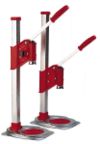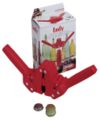m (added initial categorization) |
|||
| Line 1: | Line 1: | ||
| + | [[Category:Beer]] | ||
For the homebrewer, there are two main options for storing beer: [[bottles]] and [[kegs]]. | For the homebrewer, there are two main options for storing beer: [[bottles]] and [[kegs]]. | ||
Revision as of 20:02, 25 February 2007
For the homebrewer, there are two main options for storing beer: bottles and kegs.
Bottles
A typical five gallon batch of beer will yield approximately fifty 12oz bottles, forty 16oz bottles, or twenty-five 750mL bottles.
Advantages
- Ease of portability
- A six pack is easy to take with you.
- Ease of storage
- Beer can be stored in a closet out of the way until you're ready to chill and drink.
- Bottles can be protected from light and contained from leaking by storing in typical plastic bins. Standard sizes can easily hold one case of bottles.
- Ease of sharing
- You can divide your batch up however you please and give it away without problems.
Disadvantages
- Cleaning
- Sanitizing two cases of bottles is time-consuming and unpleasant.
- Filling
- Filling two cases of bottles and then capping them is also time-consuming
- Inconsistency
- Flavor variations from one bottle to another are a concern, as well as inconsistent carbonation.
Kegs
One five gallon batch yields one five gallon keg, obviously.
Advantages
- Cleaning
- Sanitizing one keg is quick and easy.
- Filling
- Filling a keg is as simple as racking from your fermenter and sealing the keg.
- Force Carbonation
- Instead of using priming sugar, you can force carbonate to speed along the beer towards being read to drink.
- Consistency
- The entire batch will have consistent flavor and carbonation.
Disadvantages
- Cost
- The initial costs of kegging equipment are high.
- Portability
- Kegs are more difficult to move from place to place than bottles.
- Storage
- Kegs may be stored warm, but the entire keg must be chilled, which quite a bit of room and usually requires a seperate refrigerator.
Casks
A cask is a vessel that is used to condition the ale and to serve from. After primary fermentation the ale is racked to the casks, primed and bunged. CO2 is not used for carbonation or serving, the ale is pulled from the cask by a beer engine; this results in low carbonation levels. Depending on the region of the UK, sometimes sparklers are fitted to the beer engine to release the CO2 from the ale and create a foamy head. Cask conditioned beer is referred to as "Real Ale"
Similar to "Bottle Conditioned".
Originally casks were wooden, but for reasons of cost and durability they were mainly replaced by stainless steel casks. Plastic casks are now also becoming more common.
Homebrewers not wishing to use casks but wanting to replicate cask conditioned "Real Ale" can achieve similar results with kegs by reducing the amount of primer to suit the style, and using a standard beer tap with a low CO2 serving pressure. A problem with doing this can be trub settling in the kegs and affecting the clarity of the served beer. This can be partially rectified by the addition if finings, making sure the keg is not disturbed for several days before and during serving. Cutting an inch or so off the end of the dip tube may also help.
See the Casks page for more detail


